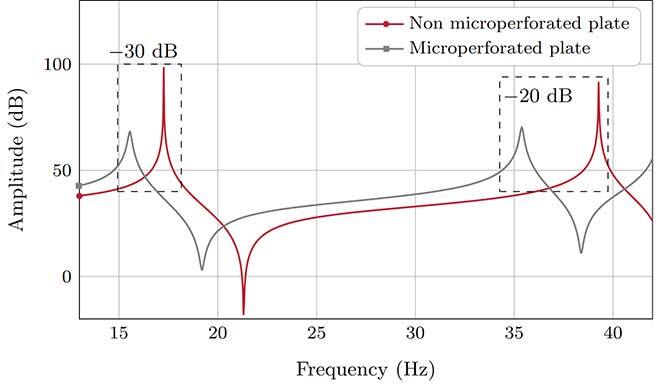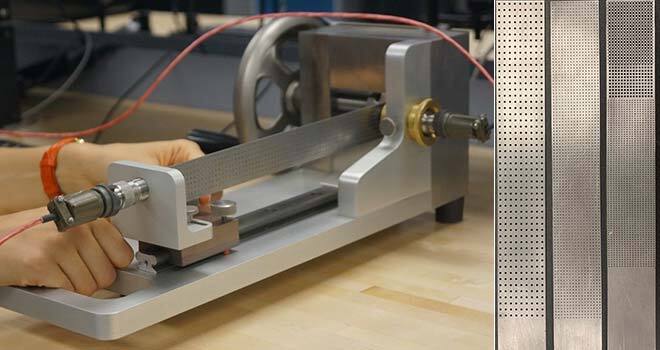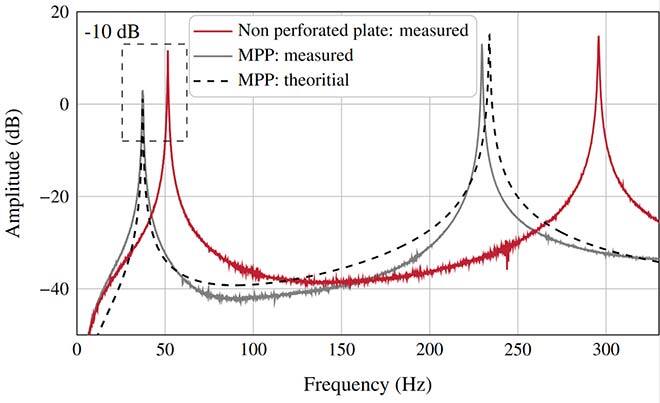
Low-frequency (LF) vibrations can generate mechanical and human health problems. To decrease vibrations and their transfer, one solution is to increase structural damping by adding viscoelastic materials. However, this solution is not always effective in low-frequency (LF) ranges. Another solution is to use dynamic absorbers. Unfortunately, applying these devices weighs down the structure, going against the trend to lighten mechanical systems in order to save energy. As a result, it is currently difficult to reduce LF vibrations effectively without adding significant mass. Therefore, it is proposed to modify the structure itself with perforations. Perforations promote interactions between the structure and the air within the structure, resulting in additional LF damping.
Keywords: Microperforated plates, structural vibration, added damping
Microperforated Plates for Low-Frequency Vibration Damping
Microperforated plates (MPPs) are simple structures currently used as sound absorbers. An MPP is a thin plate perforated with small millimetre-sized holes. It can be made from a variety of materials (metal, PVC, wood, composite, etc.). It can be used, depending on the material, in hostile environments (aircraft engines, motors, etc.), hygiene-controlled environments (hospitals, kitchens, etc.) or the building industry (ex., transparent Plexiglas MPP), etc.
MPPs absorb acoustic waves through dissipation mechanisms within the perforations. It is also a known fact that friction mechanisms between the surface of the microperforated plate and the air contained in the perforations dissipate mechanical energy. These dissipation phenomena are also observed in the open pores of a flexed porous plate, inducing additional damping to the structure. Studies have also shown that MPPs can be viewed as special porous plates: rigid with straight pores. The damping added for porous plates should therefore also appear in MPPs.
Modelling and Validation
The MPP is modeled as a porous plate with simple geometric parameters. The vibration model is adapted from the vibration approach for porous plates. Damping properties are studied both analytically and experimentally. Figure 1 shows a comparison between the analytical response of an MPP and an unperforated plate of the same size for the first two resonances. The resonance frequencies for the MPP are shifted towards the LFs in relation to the unperforated plate. Reducing the volume of material between the MPP and the unperforated structure leads to less stiffness and therefore lower resonance frequencies.
Figure 1 also shows a significant reduction in amplitude—around 30 dB in the first mode and 20 dB in the second one—between the perforated and unperforated plate. For MPPs, it is shown that the added damping is highest around a characteristic frequency that is governed by the perforation diameter. A mechanically excited finite structure responds mainly on its resonances (modes). Vibratory amplitude is therefore maximal in the vicinity of resonance frequencies. To reduce the vibratory amplitude of an MPP resonance, it is possible to make its resonance frequency coincide with the characteristic frequency by correctly selecting the perforation diameter.
In Figure 1, the perforation diameter is chosen to maximize damping in the first mode. Lower characteristic frequencies lead to greater damping effects. However, the added damping effect can act on several modes if they are LF and close to the characteristic frequency. This explains why the first two modes in Figure 1, around 17 Hz and 37 Hz respectively—being close and in the LF range—show reduced amplitudes from the perforations.

The analytical model was validated experimentally on samples (Figure 2a) using an Oberst beam (Figure 2b) to quantify the damping capacities of the tested plates.

Figure 3 shows the experimental results obtained for a plate (first in Figure 2a) with and without perforations, as well as the response obtained analytically for the MPP. The experimental results show a substantial amplitude reduction of 10 dB between a plate with and without perforations at the first resonant frequency. The perforation diameter of the MPP was chosen to maximize the added damping around the first mode to the order of 45 Hz. As the second mode has a much higher frequency—around 230 Hz—only the contribution of the first mode is reduced for this MPP. In order to reduce the vibratory amplitude of two modes whose resonance frequencies are far apart, however, it is possible to combine several perforation types of different diameters (third plate in Figure 2a). Comparisons between the model and the measurements shown in Figure 3 validate the analytical model and confirm that perforations reduce low-frequency vibration amplitudes.

This research demonstrates that MPPs can reduce vibration amplitudes in LF structures, while reducing their mass, thus opening up new prospects. These MPPs could, for example, help reduce noise and vibration in vehicle exhaust systems and aircraft engines. They could also be used to protect against shock waves and explosions, as well as in a variety of civil applications, including transport, construction, the nuclear industry, civil engineering and environmental protection. By reducing the volume of material, MPPs offer an effective alternative to viscoelastic materials for LF vibration dampening.
Additional Information
For more information on this research, please see the following paper: “L. Gallerand, M. Legrand, T. Dupont, and P. Leclaire. Vibration and damping analysis of a thin finite-size microperforated plate. Journal of Sound and Vibration, 541:117295, 2022. OA: hal-03634548.”



